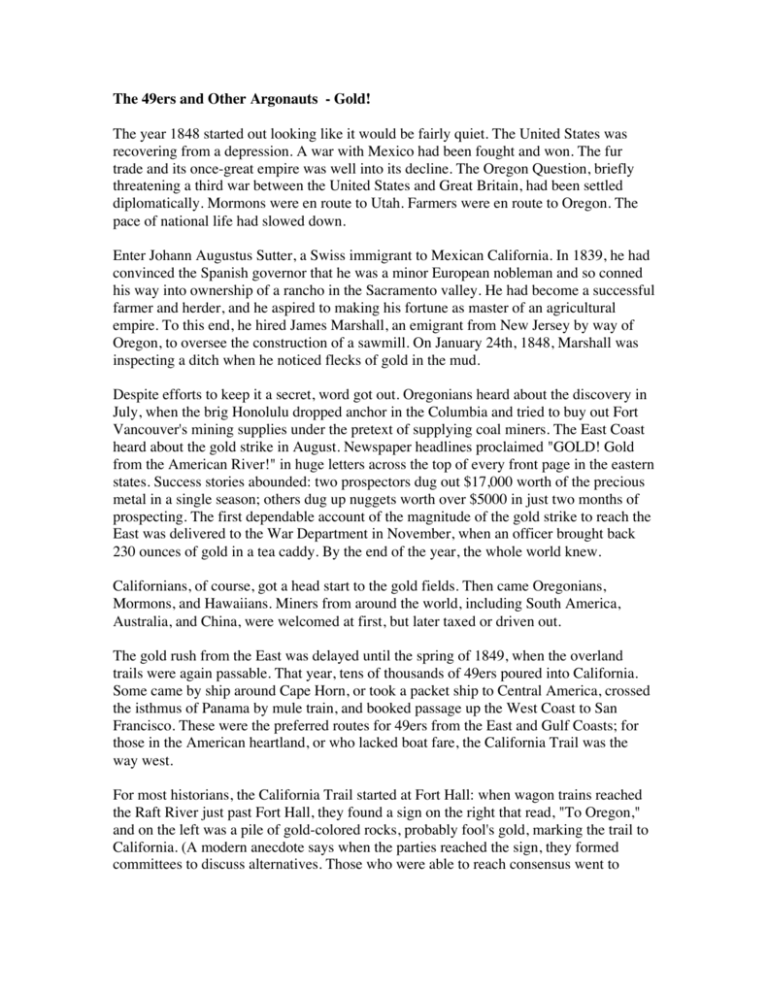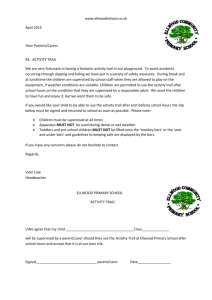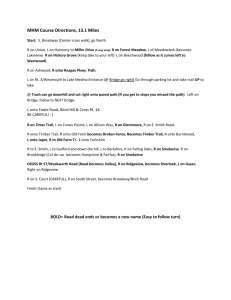The 49ers and Other Argonauts - Gold! The year 1848 started out
advertisement

The 49ers and Other Argonauts - Gold! The year 1848 started out looking like it would be fairly quiet. The United States was recovering from a depression. A war with Mexico had been fought and won. The fur trade and its once-great empire was well into its decline. The Oregon Question, briefly threatening a third war between the United States and Great Britain, had been settled diplomatically. Mormons were en route to Utah. Farmers were en route to Oregon. The pace of national life had slowed down. Enter Johann Augustus Sutter, a Swiss immigrant to Mexican California. In 1839, he had convinced the Spanish governor that he was a minor European nobleman and so conned his way into ownership of a rancho in the Sacramento valley. He had become a successful farmer and herder, and he aspired to making his fortune as master of an agricultural empire. To this end, he hired James Marshall, an emigrant from New Jersey by way of Oregon, to oversee the construction of a sawmill. On January 24th, 1848, Marshall was inspecting a ditch when he noticed flecks of gold in the mud. Despite efforts to keep it a secret, word got out. Oregonians heard about the discovery in July, when the brig Honolulu dropped anchor in the Columbia and tried to buy out Fort Vancouver's mining supplies under the pretext of supplying coal miners. The East Coast heard about the gold strike in August. Newspaper headlines proclaimed "GOLD! Gold from the American River!" in huge letters across the top of every front page in the eastern states. Success stories abounded: two prospectors dug out $17,000 worth of the precious metal in a single season; others dug up nuggets worth over $5000 in just two months of prospecting. The first dependable account of the magnitude of the gold strike to reach the East was delivered to the War Department in November, when an officer brought back 230 ounces of gold in a tea caddy. By the end of the year, the whole world knew. Californians, of course, got a head start to the gold fields. Then came Oregonians, Mormons, and Hawaiians. Miners from around the world, including South America, Australia, and China, were welcomed at first, but later taxed or driven out. The gold rush from the East was delayed until the spring of 1849, when the overland trails were again passable. That year, tens of thousands of 49ers poured into California. Some came by ship around Cape Horn, or took a packet ship to Central America, crossed the isthmus of Panama by mule train, and booked passage up the West Coast to San Francisco. These were the preferred routes for 49ers from the East and Gulf Coasts; for those in the American heartland, or who lacked boat fare, the California Trail was the way west. For most historians, the California Trail started at Fort Hall: when wagon trains reached the Raft River just past Fort Hall, they found a sign on the right that read, "To Oregon," and on the left was a pile of gold-colored rocks, probably fool's gold, marking the trail to California. (A modern anecdote says when the parties reached the sign, they formed committees to discuss alternatives. Those who were able to reach consensus went to California; those who could read the sign went to Oregon. Californians, of course, tell this joke the other way around.) Like the Oregon Trail, the California Trail is not to be confused with the trail to California. There is a difference: each emigrant, prospector, or farmer had his own trail to California. It started at their old home and ended at their new one. Along the way, they followed a well used (and later, often shortcutted) trail commonly known as the California Trail. As an emigrant road, the California Trail is exactly as old as the Oregon Trail. The 1841 Bidwell-Bartleson Party got as far as Fort Hall when half of the California-bound party decided to start their farms in the Oregon Country, instead. In the following years, most emigrants were headed to Oregon, hence the popular name Oregon Trail for the entire route. However, all that changed when gold was discovered at Sutter's Mill -- suddenly, everyone on the overland trails seemed to be heading for California. The main trunk of the California Trail cut off at the Raft River in Idaho near the City of Rocks, angled southwest to the Humboldt River near Elko, Nevada, and followed the river past Winnemucca to its demise in Humboldt Lake. Crossing Humboldt and Carson Sinks, overlanders picked up the Truckee River, passed the present-day site of Reno, and crested the Sierras at Donner Pass. This put them in the Bear River basin, which empties into the Feather and Sacramento Rivers. Always in a hurry, gold seekers took many cutoffs. Many bypassed Fort Bridger by using Sublette's Cutoff to Wyoming's Bear River. Some took Hudspeth's Cutoff straight from the Bear River to the California Trail, bypassing Fort Hall. Lansford Hastings recommended taking the Mormon Trail from Fort Bridger to Salt Lake City, circling south of the lake, crossing the Great Salt Desert, and joining the California Trail near Elko. Following Hastings' advice led the Reed- Donner Party across the Bonneville salt flats to its gruesome fate in the high Sierras, but later travelers improved the trail and rendered the route serviceable. Some gold rushers lessened the hardship of Hastings' route by going north around the lake. A popular cutoff that became so heavily trafficked as to become the main branch of the trail was the Carson Pass Trail, which left the Donner Pass route at Carson Sink, picked up the Carson River, passed Carson City, crossed the Sierras south of Lake Tahoe, and went through the gold fields of Placerville to the American River and Sutter's Fort. Much of the gold in California was discovered before the 49ers even arrived. Still, many stayed in California to farm, ranch, or open shops. Most who found gold did not make millions overnight but worked from sunup to sundown for $20 a day -- which was still a sight better than the dollar-a-day pay that was typical back East. Life in the gold fields was unlike anywhere else in the country. Camps sprang up overnight. Cabins consisted of tents or old blankets tossed over a wood frame. Dirty, muddy streets filled with garbage and sewage, and outbreaks of diseases such as smallpox and malaria were common. With so much wealth suddenly entering circulation, costs skyrocketed as merchants rushed to cash in on their own bonanza. Flour sold for $400 a barrel, sugar $4 a pound, and whiskey $20 a quart. Miners spent gold as fast as they found it. They drank, gambled, and danced with each other to Stephen Foster's popular song "Oh, Susanna." Gamblers, saloon keepers, merchants, prostitutes, and lawyers preyed on the mostly male communities. The only real buildings in boom towns were the saloons, and the only women worked in the dance halls. There was no rule of law in mining camps, and robbery, murder, and violence became common. Vigilant committees were formed, and judges called "alcaldes" were elected to keep the peace. Sacramento, San Francisco, and Stockton boomed as merchants sold out their supply of picks, shovels, knives, pans, skillets, canteens, and tents. In 1850, San Francisco was a jungle of tents and wood shacks. Its harbor was fairly littered with deserted ships. That year a fire leveled much of San Francisco, but there was so much money floating around that no one did much more than pause to take a breath before commencing the town's reconstruction. Those 49ers who went bust in California had many opportunities to search for gold elsewhere. There was a rush every year from 1850 to 1873 as strikes were made throughout the west. This was the era of boom towns such as Virginia City, Boulder, Carson City, Boise, and Denver. From 1851 to 1858, there were strikes in southern Oregon, Montana, Idaho and Nevada. Then came 1859, a banner year for mineral strikes. In Nevada, "Old Virginia" Finney and "Old Pancake" Comstock discovered a true motherlode: the famed Comstock Lode outside Virginia City. Miners brought out a million dollars a month in silver and gold during the peak of production in Virginia City. Meanwhile, other miners headed for Colorado with "Pike's Peak or Bust" painted on their wagon bonnets (about half of them later left under the slogan "Busted, by God"). From 1860 to 1864, rushes were on in Idaho and Montana as strikes there lured miners north. One monstrous nugget found in the vicinity of Helena, Montana, weighed 175 ounces. In 1873, gold was discovered on sacred Sioux land in South Dakota's Black Hills. The Sioux refused to vacate their reservation, and the US government, despite promises to the contrary, did little to discourage prospectors from invading the reservation. By 1876, thousands of miners were in the Black Hills and another round of war with the Sioux had begun. The last great strike in the lower 48 states was at Cripple Creek, Colorado, in 1891. As each gold rush cooled off and the metal became harder to find, individual prospectors left for greener pastures and mining was left to big business backed by Eastern money interests. Dynamite came to America in 1868, a boon to prospectors and mining companies alike. However, the vastly more destructive technique of placer mining was used where the terrain allowed for it. Aided by high- pressure pumps that could kill a person with the powerful stream of water they produced, men channeled streams, opened sluiceways, and literally washed entire hillsides out to sea in their search for gold. It is estimated that during the first five years of the California Gold Rush, $276 million in gold was dug out, panned, or otherwise brought to light by hand. In the next five years, the mining companies with all their manpower and heavy machinery were able to uncover only $220 million in gold. To some, the California Trail was the road to sudden wealth and prosperity; to many more, it was only a road to poverty and hardship. Within a few years, it was being used in reverse for the long trip home -- or, for those who had been hit hard by gold fever, for the considerably shorter trip to the silver mines of Nevada or the gold fields of Colorado. Written by Dr. Jim Tompkins, a prominent local historian and the descendant of Oregon Trail immigrants







